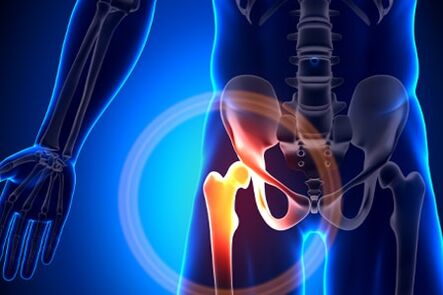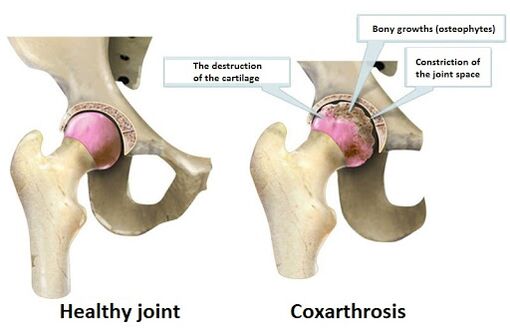
What is this disease with such an intricate name - COKSARTROSIS?.. This disease is a deforming arthrosis of the hip joint and is often also called hip joint osteoarthritis.COKSARTROSIS is currently a leader between musculoskeletal diseases, which is degenerative-distribution in nature.There are many reasons for the occurrence of very thigh disease and, in this regard, this disease has spread in all age groups.
COKSARTROSIS belongs to arthrrosis that have no inflammatory nature, in which, at first, there are degenerative-distribution changes in the hip joint cartilage, which aligns the surfaces of joint bones and, in later stages, there are already directly bone changes.In the course of a developmental course under development so gradually, there is a violation of the naturally normal functions of the affected hip joint, which finally leads to a violation of the functions of the musculoskeletal apparatus of a sick person in general.
Most of the time, hip joint arthrosis is suffered by people over forty.Obviously, coxarthrosis, like other diseases, seems possible to successfully treat without surgical intervention, but only in its early stages.But in your later stages, it is unlikely to be able to do without surgery, and only one thing can help avoid disability - joint coxarthrosis prostheses of the joint.Unfortunately, sick people, without clinging to small pain in the hip joint at the early stage of the disease, avoid seeking a doctor and hip joint osteoarthritis, meanwhile, continues to progress the day after day, gradually turning into a more neglected form.

How COKSARROSIS develops
Let's look at the mechanism of developing disease coxarthrosis.And we started with the fact that the hip board consists of two bones:
- the end of the femur, similar to a ball;
- Giro, similar to a small lush billiard located on the iliac part of the pelvis;
- A special joint cartilage on the surface of both bones, similar to a substance such as a sponge and necessary as a shock absorber, which is compressed during movement and straightening in its absence;
- as well as the ligaments that form the hip joint cavity itself and thus form the joint capsule.
Surrounded by articulation, in addition, there is muscle tissue, somehow femoral, glute and other muscles, about the functionality on which the state of the hip joint also depends.
During movement, when compressing joint cartilage, a specific fluid is "squeezed" in the joint, which is a type of lubricant for bones that are articulated in the joint.In addition, joint cartilage itself, in addition, performs the function of the uniform distribution of loads on the articulation surface, being an excellent shock absorber during the movements.
The very occurrence of thigh is mainly due to the fact that the power of the hip joint cartilage is disturbed.The cartilage becomes thinner and later disappears in some places.If you do not take action to stop this process, then where the cartoon described animated cartoon occurs, the bone itself will grow directly, trying to "fill" the void of the articular cavity with oneself.As a result of such bone changes, so osteophytes begin to appear, that is, "peaks" in the bones.These deformations, in turn, lead to a violation of the congruence of bones that are articulated in the hip joint and the subsequent "abrasion" of the still healthy sections of joint cartilage.
The causes of hip articulation arthrosis
The causes of coxarthrosis from which it arises can be divided into primary, having little and secondary etiology as a result of other diseases, such as:
- Luxation of the thigh, which is innate;
- Femoral dysplasia;
- Aseptic necrosis of femoral head itself;
- Previously transferred several injuries, this fracture of the thigh neck;
- Affects diseases;
- inflammatory processes in the hip joint;
Since coxarthrosis disease is found not only for one but at the same time the two hip joints, it is quite possible to say that bilateral cOKSARROSIS is a rarity.Although with primary coxarthrosis, the knee joint or spine is usually also affected.
Caxartrosis symptoms
The first symptoms of coxarthrosis depend directly on the degree of hip joint damage, as well as at the stage of development of this disease, and the main ones are:
- The pain manifested itself during the movement, in the hip joint, and disappearing at rest;
- Claudication;
- rigidity that appeared in the hip joint;
- Descendant progress of hip movements;
- The weakness of the femoral muscles and a noticeable decrease in their volume.
Separately, we consider the symptoms of coxarthrosis, depending on the degree of the disease with this disease:
- 1st degree symptoms of thigh: in the hip joint, there are moderate pain and only after the joint is subjected to intensive load for a long time.After removing the load and rest, this syndrome is completely interrupted.In the first degree, the symptoms of gear cOKSARROSIS remain common and the volume of joint movements does not change.
- The 2nd degree symptoms of thigh: hip joint pain are more intense senses than in the first degree, but besides, they are projected in the inguinal region.Due to developing muscle atrophy, the knee begins to get sick and the knee, and often strongly.Sometimes, with the symptoms of second degree cooesarthrosis, the pain begins to appear at rest and, after the load in the affected joint, a very long rest is already required to prevent it.Closing begins to appear by running or walking for a long time.At the same time, the strength of the hip muscles is greatly reduced and the volume of joint movements is also underestimated.
- 3rd degree symptoms of thigh: a constantly pronounced pain syndrome in the hip joint, not even after an extremely long or constant rest at night, even at night.The pain has already been completely affected throughout the leg.Against the bottom of the pain, the sick man develops insomnia and various sleep disorders.There is a strong atrophy of the thigh muscles, buttocks and legs, while the joint engine volume is almost minimal.When walking, a sick person to move is forced to resort to auxiliary means, such as a cane, for example.
If this hip joint arthrosis develops only at the hip joint hip, its weakened femoral muscles give a boost to the development of the lateral displacement of the pelvis, because the length of the leg with the joints affected by thigh decreases.
COKSARTROSIS DIAGNOSIS
By conducting the diagnosis of coxarthrosis, the symptoms of thigh, described above, in combination with the data obtained from a patient's radius -x exam, are taken into consideration.This technique provides the possibility of determining not only the degree of coxarthrosis, but also identifying the causes that served as a catalyst for the development of thigh.Radiography offers an excellent opportunity to determine changes taken specifically to hip joint injuries, which is directly related to the mechanisms of the development of thigh.
In addition to the diagnostic methods already listed, computed tomography methods and magnetosonance images can also be used, providing the possibility of a complete detailed study of developing pathology, such as bone tissue, whose deformation is a satellite of this disease.As for magnetic resonance imaging, this method also allows the evaluation of pathological disorders to which soft tissues surrounding the joints affected by thigh were subjected.

Treatment of hip joint arthrosis
The choice of treatment for cOKSARTROSIS depends directly on the symptoms of this disease and its internship.Normally, in the first and second degree of hip arthrosis, a traditional conservative drug therapy is performed, consisting of ingestion of chondroprotectors, vasodilators and, according to indications, also muscle relaxants.During the period when thigh is especially acute and anti -inflammatories non -esteroids are also used.It should be borne in mind that this treatment should be performed by a specialist, as drug self-medication, unlike traditional medicine, can have an extremely negative effect on the patient's internal organs and completely suppress the ability to restore hyaline cartilage.
In addition, with hip arthrosis, various physiotherapeutic procedures and exercise therapy are prescribed.
Especially effective, combined with the traditional drug treatment of hip arthrosis, is the use of the magnetotherapy method.The magnetotherapy method in the early stages is especially effective - avoids dystrophic changes and returns to disease.In later stages, the method increases performance and quality of life, reduces the risk of complications in the affected joint.
The impact on the body of the patient with thighs does not have a directly therapeutic effect with a diet, but recommended that obese people reduce body weight, as it allows to reduce the load in the affected joint, thus facilitating acute symptoms of coxartrosis.

As for the third degree of thigh, whose symptoms are more painful, treatment, as such, is performed only through surgical intervention, for example, an endoprothetic hip joint is performed.
The endoprosthesis includes components that are functional analogs of the hip joint.This orthopedic product is installed inside the limb, which is determined by its name (Endo - from the Greek "inner").An artificial replacement of hip joint performs a musculoskeletal function, but, unlike the natural joint, lubricating fluid does not occur.Yes, it is not necessary, since this prosthesis is made of materials that, without any lubrication, slide easily and do not destroy.
Statistical data indicate that after surgery, the absolute restoration of members with hip joint deforming arthrosis is achieved in 95% of cases, which allows later a very active lifestyle.
The life of such a prosthesis is about 15 ... 20 years, but at the end of its service, a second operation is required to replace a spent endoprosthesis.
ObserveIt's important!Don't diagnose!In the case of symptoms of coxarthrosis, you should consult an orthopedic doctor, as only a qualified specialist can make a correct diagnosis and prescribe the most ideal treatment.
Coxarthrosis prevention
Coxarthrosis disease can also be avoided if the necessary prevention of cOKSARROSIS is performed:
- Mandatory and timely treatment of inflammatory joint diseases;
- timely treatment of joint dysplasia;
- Correct and reasonable physical activity, especially weights with weights that must be performed correctly;
- Mandatory control of your body weight, with its maintenance normally;
- The prevention of joint injuries.


















